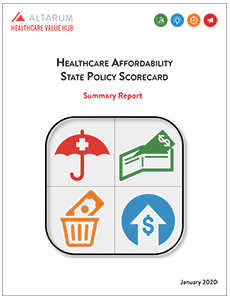2020 Healthcare Affordability State Policy Scorecard - Summary Report
Executive Summary
Polling data repeatedly shows that healthcare affordability is the number one issue that state residents on both sides of the political aisle want their policymakers to work on.1 To inform policy conversations and support policymaker responsiveness, this Healthcare Affordability State Policy Scorecard details a variety of approaches to addressing the burden of healthcare affordability.
While there is more than one path to healthcare affordability, core elements include:
- Enacting policies to ensure affordable coverage options for all;
- Ensuring coverage options feature affordable cost-sharing and don’t leave consumers underinsured or create barriers to high-value care; and
- Addressing the underlying causes of high healthcare costs by reducing spending on low-value care and curbing excess prices.
In addition to examining policies in each of these areas, the scorecard looks at related outcomes, giving states credit for strong outcomes even if the policy environment is missing some key policy actions.2
Key Findings
- No state earned a perfect score overall. The highest ranked state, Massachusetts, performed well on many policy measures, but still needs to enact stronger protections against surprise medical bills and pursue additional strategies to reduce the cost of high-value care.
- Massachusetts, Vermont and Oregon were the highest scoring states in terms of policy actions to extend affordable coverage to all state residents, while Massachusetts, the District of Columbia and Vermont scored the highest in terms of coverage outcomes (i.e., reducing the portion of the population that is uninsured).3 Unlike our other domains, almost all states have taken one or more actions to improve access to coverage.
- New York, followed by New Jersey and Colorado, scored the highest in terms of policies to make out-of-pocket (OOP) costs affordable. However, Maryland residents (followed by MA, NY, CA, CT, and DC) reported the lowest levels of healthcare affordability burden (i.e., struggles paying for out-of-pocket healthcare costs).
- This measure—overall affordability burdens among adults—reveals that, even in high scoring states like Maryland, one quarter of adults still report healthcare affordability burdens.4 These burdens can impact as many as 57 percent of a state's adult residents, as reported in Mississippi.
- Policies to reduce the provision of low-value care were difficult to tabulate at the state level, as were outcomes related to low-value care. For this category, Massachusetts and Maryland once again received the highest policy scores, but Alaska and Idaho scored best in terms of the outcome measures for low-value care. As discussed below, we were surprised to see how similarly states scored across the two outcome measures for this category.
- Our examination of policy measures to address excess prices assigned the top score to Oregon, followed by Massachusetts. However, Arkansas—followed by Maryland—performed best in terms of keeping private payer prices below the national median.
The unique dataset complied for this scorecard exercise allows us to look at correlations between the measured outcomes and policies.
- The coverage policies were fairly well correlated with coverage outcomes (R=.63;5 50 states, plus DC) and with OOP affordability outcomes (R=.70; 49 states, plus DC). Similarly, policies to address OOP costs were well correlated with OOP affordability outcomes (R=.58; 49 states, plus DC).
- Policies and outcomes were poorly correlated for the “reduce low-value care” and “curbing prices” categories-which is likely due (at least in part) to the challenge of identifying outcome measures that are available for most states and that reliably signal the desired outcome. In addition, there is likely a time lag involved that is beyond the scope of this report to incorporate. Time lag accounts for the time for needed for policy actions to alter provider treatment patterns and to rein in market dynamics that have allowed unfettered price growth for years or sometimes decades.
Some data was included in the scorecard for informational purposes but not scored, including: per capita state healthcare spending (a low value could be positive or negative, depending on whether residents are getting the services they need) and private payer prices relative to Medicare (only 25 states had this data). An interesting finding in this data is that:
- Michigan reported the best performance (out of 25 states) in terms of keeping private payer prices close to what Medicare pays.6
Incorporating this unscored data on per capita state healthcare spending reveals that:
- Some states have historically high healthcare spending per person, but existing policies appear to be working to address healthcare affordability as evidenced by scorecard outcomes (see, for example, Massachusetts, District of Columbia, Connecticut and New York). Massachusetts exemplifies a small cadre of states that have relatively high healthcare spending per person, but a comparatively low percentage of residents reporting affordability problems. Additionally, recent spending growth in Massachusetts has moderated, suggesting that policy efforts are achieving some success.7
- Occasionally, historically low-spending states have parlayed that advantage into good affordability outcomes for their residents (see, for example, New Mexico).
But a far more common outcome is that the residents of both high- and low-spending states are reporting grave healthcare affordability burdens.8 As noted above, fully one quarter of adults report healthcare affordability burdens in our best performing states, rising to 57% of adults in our worst performing states. This scorecard is a call-to-action and road map for people and policymakers to strengthen efforts to address state residents’ top priority.







